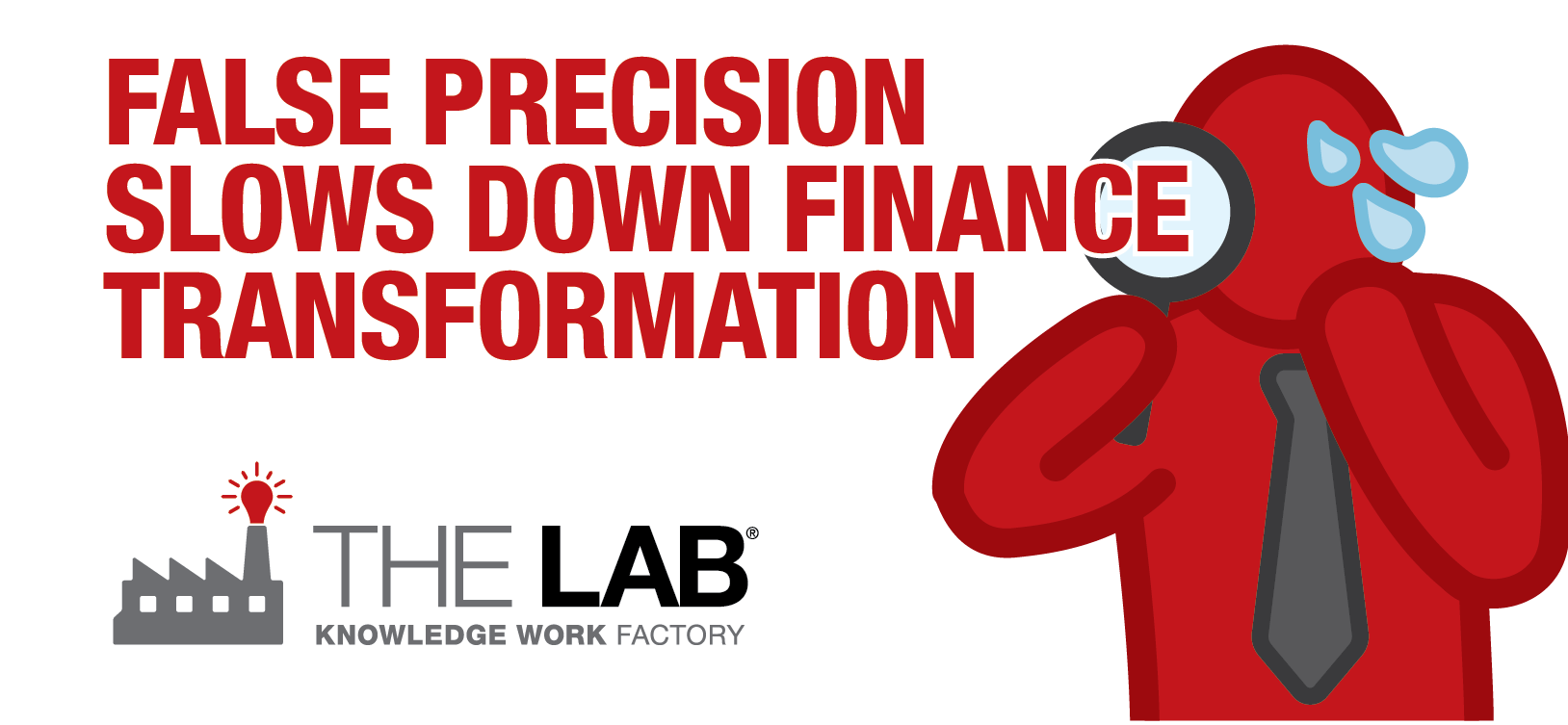“Measure with a laser beam, mark with a chalk line, cut with an axe.”
– Anonymous
Have you ever watched an transformation project stall out because someone demanded an impossible level of precision in estimating the results? Typically, the detail requested for the project far exceeds the company’s current practice – and does not affect the decision. Inconsistent, often contradictory demands for detail in business today are so widespread, costly and predictable that reducing them is a valuable improvement opportunity itself.
Have you ever watched an transformation project stall out because someone demanded an impossible level of precision in estimating the results?
Yet these startling inconsistencies hide comfortably in plain sight, rarely drawing a second glance. That’s because discovering these opportunities requires a fundamentally different, unconventional approach to perceiving business value – a cognitive approach. False Precision is just one of many Cognitive Business Improvement Opportunities that savvy executives can seize to convert predictable, commonplace misperceptions into significant sources of value.
Lean Finance Transformation in a Fortune 250 Company and What Went Wrong
A Fortune 250 firm was designing a lean initiative to streamline and transform its finance department’s operations. Hundreds of small improvements together represented annual cost savings of more than $150 million. These savings would fall directly to the company’s bottom line and increase profit in less than six months. The effort would return well over ten times its cost within the first year. No technology was required. The finance transformation project team considered the go-ahead decision a “no brainer.”
One executive, however, balked when he noticed that each individual improvement of the finance transformation project was not analyzed separately on a cost/benefit basis – an expensive, tedious task that would take months and not change the direction of the project. On the surface, the objection might seem reasonable. The company, after all, planned to invest a significant amount of time and effort, and the executive might have argued that no rational investor would risk capital without a clear explanation of where that money was going. True, but at the same time, no rational investor would pass on such a low risk, high payback opportunity to increase shareholder value through finance transformation. And the primary job of the finance department is to act as the internal experts for increasing the value of the company.
It happens because conventional management methods are designed to detect and capture value in expected places. When value appears in unexpected places, it presents a challenging inconsistency for both managers and their conventional methods.
In the end the lean finance transformation initiative was scrapped, the company and its shareholders lost out on the value, and nobody but the disappointed improvement team even knew what took place. A major decision was made for the company based on the objections of one executive. A $150 million prospective saving vanished. Neither the CFO nor the CEO had any inkling of what occurred. At the same company, an executive’s travel voucher request receives more thoughtful and rational review.
False Precision in Lean Finance Transformation Projects
This is the costly logical error of False Precision – unreasonable detail required inconsistently and unnecessarily, often in stark contrast to existing practices and work routines. Mistakes of consistency can happen everywhere; they are expected. But it’s also expected that they will be quickly noticed and corrected. Mistakes of False Precision go unnoticed and uncorrected. Nobody seems to bat an eye. These errors are mistakes born of perceptual inconsistency, and they hide breathtaking gaps in business strategies and finance operations.
To appreciate the magnitude of these hidden gaps, let’s take a look at the finance operations of that same, cautiously precise finance group. In practice, will we find the level of precision that was demanded of the proposed improvement? No, not even close. How many employees work in the finance group? No “precise” figure can be given – the estimate, several thousand, is plus or minus 20%. How many management reports does the finance group produce? No inventory has ever been taken. How satisfied are its internal customers? No survey has ever been conducted.
Mistakes of False Precision go unnoticed and uncorrected. Nobody seems to bat an eye. These errors are mistakes born of perceptual inconsistency, and they hide breathtaking gaps in business strategies and operations.
So, why then subject a proposed finance transformation project to a higher standard of virtually unattainable precision? Why does the company have to lose out on the $150 million? And why is this loss unnoticed?
It happens because conventional management methods are designed to detect and capture value in expected places. When value appears in unexpected places, it presents a challenging inconsistency for both managers and their conventional methods. For example, it is expected that the travel vouchers mentioned above will provide an opportunity for the organization to lose value if they are not monitored closely. Similarly, it is expected that a shortage of parts on the assembly line will result in a loss of value. Consequently, every business maintains methods to scrutinize both of these areas, evaluate the facts and make decisions to preempt the expected losses of value.
But nobody expected to find hundreds of finance operations process improvements worth $150 million in the finance group. And the sudden appearance of vast amounts of unexpected value from a finance transformation project can be very disruptive. It highlights gaps in conventional management perceptions and beliefs. It demonstrates weaknesses in existing finance and accounting operations. Most importantly, it shows the lack of methods and interest devoted to capitalizing on similar gaps or blind spots in conventional management perception. These gaps in management perception leak business value like a sieve, and nobody notices. They can be predictably found in the usual places – over and over again. They deliver what can be termed Cognitive Business Value and they deserve their own dedicated and highly unconventional improvement program.
In the example above of finance transformation hurdles, management’s perceived need for False Precision may have been well intentioned. It will, however, quickly conceal an unexpected, highly valuable improvement opportunity and quietly maintain the status quo. False Precision represents only one of several dozen Cognitive Business Improvement Opportunities. Best of all, no new management capabilities need to be developed to transform. All are typically resident in the business – they are just inconsistently and conventionally applied.
Cognitive Business Value hides in plain sight. To see it, you have to look with your mind.
Are you in need of lean finance transformation?
Simply call (201) 526-1200 or email info@thelabconsulting.com to book your demo today!

















